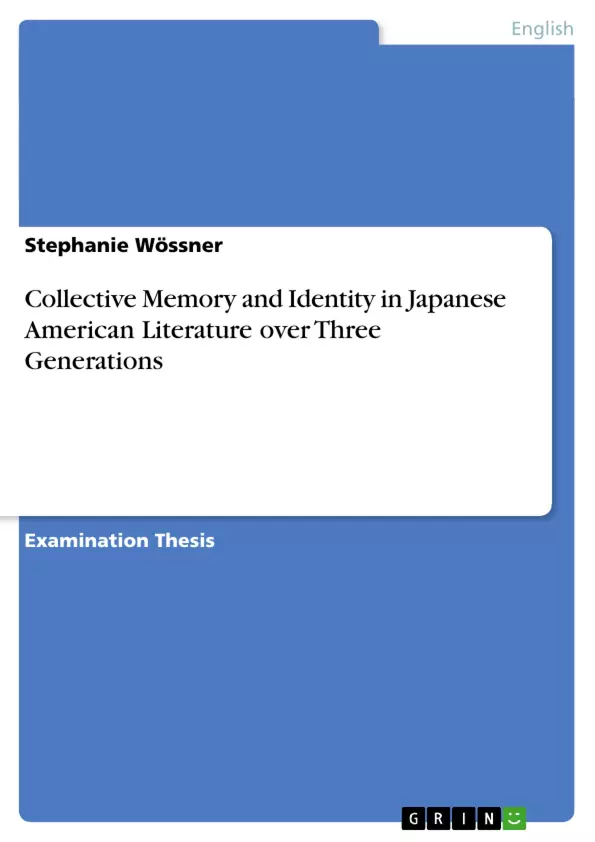This thesis will show that the collective memory does not pose a problem to the whole of humanity but that it still exists in some spheres of in this case American life.
Inhaltsverzeichnis (Table of Contents)
- TERMINOLOGY
- PREFACE
- I INTRODUCTION
- II THEORY
- A Collective Memory
- 1. History
- 2. Definition
- a Maurice Halbwachs
- b Jan and Aleida Assmann
- 3. Characteristics
- a Construction
- b Selection
- 4. Trajectory
- B Collective Memory and
- 1. Collective Memory and History
- 2. Collective Memory and Canon
- 3. Collective Memory and Trauma
- 4. Collective Memory and Time
- 5. Collective Memory and Place
- 6. Collective Memory and Identity
- a Identity
- b (Ethnic) Counter Identity
- i Orientalism
- ii Stereotypes
- c Collective Memory and Identity
- 7. Collective Memory and Resistance
- 8. Collective Memory and Literature
- C Hegemony, Dialogue, Therapy
- 1. Antonio Gramsci
- a Hegemony
- b Collective Memory and Antonio Gramsci
- 2. Mikhail Bakhtin
- a Language
- b Carnival
- c Collective Memory and Mikhail Bakhtin
- 3. Hayden White
- a Narrative
- b Therapy
- c Text and Therapy
- d Collective Memory and Hayden White
- D Collective Memories
- 1. History
- a The US – A Nation of Immigrants
- b Japanese in the US
- 2. Collective Memory
- a Collective Memory in the US
- b Collective Memory in Japanese America
- III THESIS: JAPANESE AMERICAN LITERATURE – COUNTER-HEGEMONY, DIALOGUE WITH THE PAST, THERAPY
- IV JAPANESE AMERICAN LITERATURE
- A Issei Literature – Violet Kazue de Cristoforo's May Sky: There is Always Tomorrow. An Anthology of Japanese American Concentration Camp Kaiko Haiku
- 1. Background Information
- a Haiku and Kaiko Haiku
- b The Editor
- c The Book
- d The Historical Circumstances
- 2. Observations and Interpretation
- a Observations: Collective Memory
- i Communicative Memory
- ii Cultural Memory
- b Interpretation
- i The Camp Experience
- ii Theoreticians' Relevance
- c Summary
- B Nisei Literature - Toshio Mori's Yokohama, California(1949)
- 1. Background Information
- a The Author
- b The Book
- c The Historical Circumstances
- 2. Observations and Interpretation
- a Observations: Collective Memory
- i Communicative Memory
- The role of collective memory in shaping and negotiating identity.
- The impact of historical trauma on Japanese American communities and their literary representations.
- The power of literature to challenge hegemonic narratives and construct alternative perspectives.
- The interplay between cultural memory, history, and place in shaping the Japanese American experience.
- The use of literary techniques, such as haiku and narrative, to convey and preserve collective memory.
- Chapter I: Introduction
- Introduces the research topic, providing context for the study of collective memory and identity in Japanese American literature.
- Outlines the theoretical framework and methodology employed throughout the work.
- Defines the scope of the research and the specific texts to be analyzed.
- Chapter II: Theory
- Explores the theoretical foundations of collective memory, drawing on key theorists such as Maurice Halbwachs and Jan and Aleida Assmann.
- Discusses the characteristics of collective memory, including its construction, selection, and trajectory.
- Examines the interrelationship between collective memory, history, trauma, time, place, and identity.
- Addresses the role of hegemony, dialogue, and therapy in shaping and mediating collective memory.
- Analyzes the perspectives of theorists such as Antonio Gramsci, Mikhail Bakhtin, and Hayden White.
- Chapter III: Thesis: Japanese American Literature – Counter-Hegemony, Dialogue with the Past, Therapy
- Presents the main argument of the study, asserting the significance of Japanese American literature as a vehicle for counter-hegemony, dialogue with the past, and therapy.
- Highlights the ways in which Japanese American writers engage with collective memory to challenge dominant narratives and reclaim their history.
- Explores the therapeutic potential of literature to confront historical trauma and promote healing within communities.
- Chapter IV: Japanese American Literature
- A: Issei Literature – Violet Kazue de Cristoforo's May Sky: There is Always Tomorrow. An Anthology of Japanese American Concentration Camp Kaiko Haiku
- Provides background information on the anthology, including the historical context, the editor, and the nature of kaiko haiku.
- Analyzes the anthology's representation of collective memory, focusing on themes of communicative and cultural memory.
- Interprets the anthology's depictions of the camp experience and the ways in which it engages with theoretical concepts.
- B: Nisei Literature - Toshio Mori's Yokohama, California(1949)
- Presents background information on the novel, including the author, the book, and the historical circumstances.
- Examines the novel's representation of collective memory, focusing on themes of communicative memory.
Zielsetzung und Themenschwerpunkte (Objectives and Key Themes)
This work aims to explore the concept of collective memory and its relationship to identity in Japanese American literature across three generations. The study analyzes the literary representations of the past and how they contribute to the formation and understanding of identity within the context of Japanese American history and culture. The key themes explored in this work include:Zusammenfassung der Kapitel (Chapter Summaries)
This section summarizes the main themes and arguments of each chapter, excluding the final chapter and any spoilers.Schlüsselwörter (Keywords)
This study explores key concepts such as collective memory, identity, Japanese American literature, counter-hegemony, dialogue with the past, therapy, historical trauma, cultural memory, communicative memory, place, and time. The focus of this work is on understanding the ways in which these concepts are intertwined within the context of Japanese American literature.
Excerpt out of 105 pages
- scroll top
- Quote paper
- B.A. Stephanie Wössner (Author), 2005, Collective Memory and Identity in Japanese American Literature over Three Generations, Munich, GRIN Verlag, https://www.hausarbeiten.de/document/138114
Look inside the ebook


